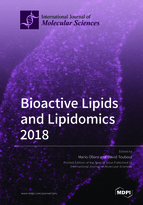Bioactive Lipids and Lipidomics 2018
A special issue of International Journal of Molecular Sciences (ISSN 1422-0067). This special issue belongs to the section "Bioactives and Nutraceuticals".
Deadline for manuscript submissions: closed (31 January 2019) | Viewed by 71380
Special Issue Editors
Interests: lipid signaling; membrane microdomains; protein-lipid interactions
Special Issues, Collections and Topics in MDPI journals
Interests: antimicrobial compounds; fatty acid; lkaloids; phytochemicals
Special Issues, Collections and Topics in MDPI journals
Special Issue Information
Dear Colleagues,
Recent advances in technologies for lipid analysis have contributed to the consolidation of lipidomics as a particular discipline in metabolomics. This technological development has paralleled the discovery of a broad range of cellular functions associated with lipids, from cell signaling and membrane dynamics, to intercellular communication and the regulation of gene expression. Lipid molecules have been identified as therapeutic targets, therapeutic agents, nutraceuticals and disease biomarkers.
The scope of this Special Issue is to provide the readers from the disciplines of chemistry, biology, as well as connected disciplines with the state-of-the-art of lipid science with regard to the progress in the discovery of bioactive lipid and technical advances in lipidomics.
Authors are invited to submit original research and review articles. Topics include, but are not limited to:
- Bioactive lipids in cell biology
- Lipid molecules as therapeutic agents, nutraceuticals
- Lipids as diagnostic and prognostic biomarkers of disease
- Lipids in systems biology and metabolic networks
- New advances in lipid analysis and lipidomics
Prof. Dr. Mario Ollero
Dr. David Touboul
Guest Editors
Manuscript Submission Information
Manuscripts should be submitted online at www.mdpi.com by registering and logging in to this website. Once you are registered, click here to go to the submission form. Manuscripts can be submitted until the deadline. All submissions that pass pre-check are peer-reviewed. Accepted papers will be published continuously in the journal (as soon as accepted) and will be listed together on the special issue website. Research articles, review articles as well as short communications are invited. For planned papers, a title and short abstract (about 100 words) can be sent to the Editorial Office for announcement on this website.
Submitted manuscripts should not have been published previously, nor be under consideration for publication elsewhere (except conference proceedings papers). All manuscripts are thoroughly refereed through a single-blind peer-review process. A guide for authors and other relevant information for submission of manuscripts is available on the Instructions for Authors page. International Journal of Molecular Sciences is an international peer-reviewed open access semimonthly journal published by MDPI.
Please visit the Instructions for Authors page before submitting a manuscript. There is an Article Processing Charge (APC) for publication in this open access journal. For details about the APC please see here. Submitted papers should be well formatted and use good English. Authors may use MDPI's English editing service prior to publication or during author revisions.
Keywords
- Lipidomics
- Bioactive lipids
- Biomarkers
- Nutraceuticals
- Metabolomics
- Membrane dynamics
- Imaging








